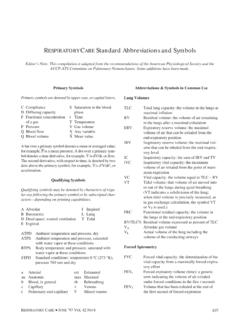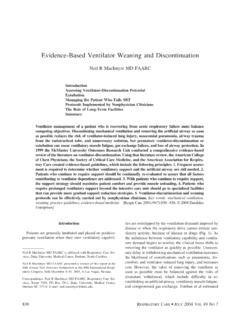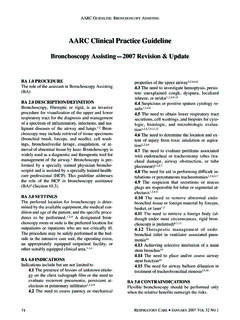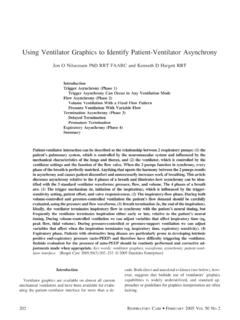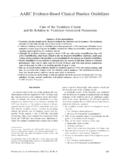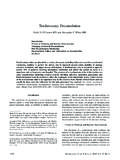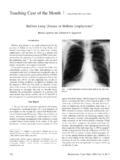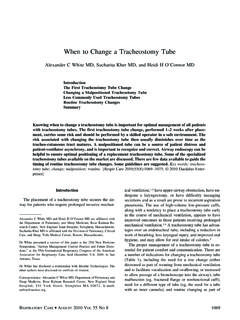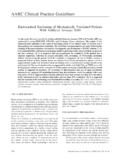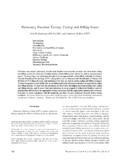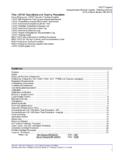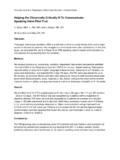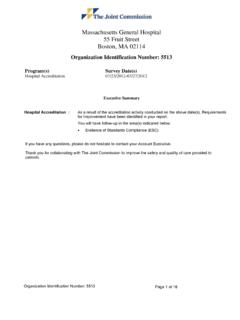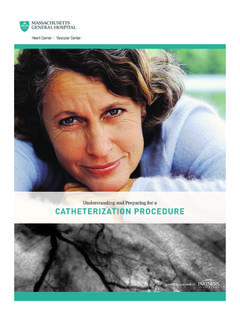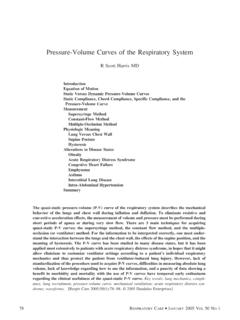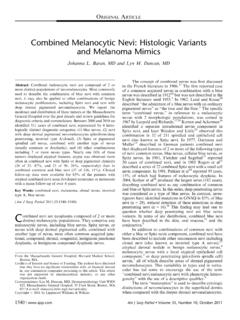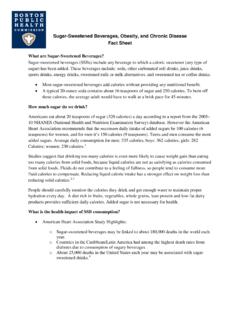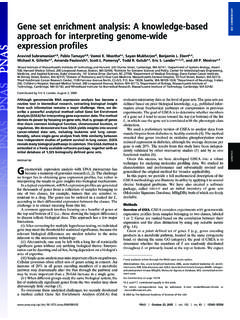Transcription of Retrospective Studies and Chart Reviews - Respiratory Care
1 Retrospective Studies and Chart ReviewsDean R Hess PhD RRT FAARCI ntroductionCase SeriesCase-Control StudyMatched Case-Control StudySummaryA Retrospective study uses existing data that have been recorded for reasons other than Retrospective case series is the description of a group of cases with a new or unusual disease ortreatment. With a case-control study, cases with and without the condition of interest are identified,and the degree of exposure to a possible risk factor is then retrospectively compared between the2 groups. With a matched case-control study, control subjects are selected such that they resemble(match) the cases with regards to certain characteristics (eg, age, comorbidity, severity of disease). Retrospective study designs are generally considered inferior to prospective study , a Retrospective study design should never be used when a prospective design words: research, Respiratory care, research methodology, study design, Retrospective , casecontrol.
2 [Respir Care 2004;49(10):1171 1174. 2004 Daedalus Enterprises]IntroductionA Retrospective study uses existing data that have beenrecorded for reasons other than research. In health carethese are often called Chart Reviews because the datasource is the medical record. Figure 1 contrasts retrospec-tive and prospective Studies . There are 3 general types ofretrospective study: case report, case series, and case-con-trol study. A Retrospective study contains many of thesame study-design elements as a prospective study (Table1). Many times investigators view Retrospective Studies as quick and dirty because the data are quickly gleanedfrom existing records to answer a question. However, awell done Retrospective study may not be quick and isdefinitely not dirty. Although a Retrospective design isusually discouraged when a prospective study is feasible,a Retrospective study can serve a useful purpose.
3 A par-ticularly useful application of a Retrospective study is as apilot study that is completed in anticipation of a prospec-tive study. The Retrospective study can help to focus thestudy question, clarify the hypothesis, determine an appro-priate sample size, and identify feasibility issues for aprospective SeriesAcase reportis a report of one unusual and/or instruc-tive case (eg, symptoms not previously observed with agiven medical condition, or an unexpected or new combi-nation of medical conditions in one case), whereas acaseseriesis a report of multiple similar unusual or instructivecases. A Retrospective case series can be used to study adisease that occurs infrequently or to generate a hypothesisthat can be tested more rigorously in a prospective R Hess PhD RRT FAARC is affiliated with the Department ofRespiratory Care, Massachusetts General Hospital, and Harvard MedicalSchool, Boston, R Hess PhD RRT FAARC presented a version of this article at theRESPIRATORYCAREJ ournal symposium, The ABCs of Research, at the49th International Respiratory Congress, held December 8 11, 2003, inLas Vegas, : Dean R Hess PhD RRT FAARC, Respiratory Care,Ellison 401, Massachusetts General Hospital, 55 Fruit Street, Boston MA02114.
4 E-mail: OCTOBER2004 VOL49 NO101171 There are several important disadvantages of a case , as with any Retrospective study, the investigator de-pends on the availability and accuracy of the medical , a case series is subject to selection bias becausethe investigator self-selects the cases. Third, a case seriesis few examples will illustrate the case series design. Inthe mid-1990s, inhaled nitric oxide (INO) was used inrelatively few hospitals worldwide. One of the largest ex-periences with INO was at the Massachusetts General Hos-pital. Manktelow et al1reviewed that experience, whichincluded 88 patients with acute Respiratory distress syn-drome. They reported a clinically important response toINO (improvement in oxygenation) in 58% of the patients,consistent with what was subsequently reported in pro-spective controlled trials.
5 They also used a multivariatelogistic regression model to analyze the effect of multiplevariables on the responsiveness to INO, which showed thatonly septic shock remained a significant discriminant forresponsiveness to INO. Because the majority of patientswith acute Respiratory distress syndrome demonstrate aclinically useful physiologic response to INO, the logicalnext hypothesis to be tested was whether INO improvessurvival in those patients. Unfortunately, subsequent pro-spective randomized, controlled trials showed no survivalbenefit for INO with patients with acute Respiratory dis-tress ,3 Another example of a Retrospective case series comesfrom Wijkstra et summarized the outcomes of allthe patients admitted to an in-patient, long-term, assisted-ventilation unit between 1986 and 2001. They concludedthat such a unit can provide a safe environment for severelyimpaired, ventilator-dependent patients.
6 About a third of thepatients eventually left for a more independent community-based care setting. Better outcomes were seen among pa-tients with spinal cord injury and neuromuscular diseasethan among patients with chronic obstructive pulmonarydisease and thoracic restriction. This was an appropriatetopic for a Retrospective study because there are few ofthese patients (only 50 patients in 15 years) and there arefew hospitals that have specialized units for these StudyA case-control study, although Retrospective , is superiorto a case series because of the presence of a control with and without the condition of interest are iden-tified. The degree of exposure to a possible risk factor isthen compared between the 2 groups. The case-controlstudy design assumes that (1) cases differ from controlsonly in having the disease, (2) exposure should be equallydistributed between cases and controls if the exposure doesnot cause the disease, and (3) greater exposure amongcases would indicate that exposure increases the risk of thedisease.
7 The exposure is determined retrospectively. Ide-ally, the data collectors are unaware of whether a subjectis a case or a control, and the data collectors should beunaware of the study hypothesis. The cases and the con-trols must be assessed for exposure in the same way. Fig-ure 2 illustrates the case-control study design. Figure 3compares a case-control study to a prospective random-ized types of study bias are unique to case-controlstudies. For hospital-based case-control Studies the studypopulation is the collection of clinical records of the par-ticipating hospital. However, the cases and the controlsmay have had different hospital admission rates; this iscalled Berkson s bias. For example, many patients withFig. 1. Prospective versus Retrospective study design. In a pro-spective study, the baseline state of the subjects is determined,the controlled intervention is applied, and then the outcome ismeasured.
8 In a Retrospective study, the intervention, baseline state,and outcome are obtained from existing information that was re-corded for reasons other than the Elements in a Retrospective Study Design*1. Write the study question2. Develop the hypothesis3. Search the literature4. Consider the statistical issues, such as sample size and how theresults will be analyzed5. Write the protocol: where the data will be found, what data willbe needed, how data will be collected, how data will be analyzed6. Obtain permission: institutional review board (patient?), datasource (eg, medical records department)7. Collect the data8. Analyze the data9. Explain the results10. Write the report*Note that these are by and large the same as the elements of a prospective study ANDCHARTREVIEWS1172 RESPIRATORYCARE OCTOBER2004 VOL49 NO10asthma are not admitted to the hospital.
9 A case-controlstudy of asthma using hospital records would select onlythe most severe cases. For population-based case-controlstudies the study population is the collection of subjectswho would become cases if they developed disease. Thiscan result in cases that are not representative of the in-tended population; this is called Neyman s commonly used statistic for case-control Studies is theodds ratio, defined as the ratio of the odds of an outcomein an exposed group to the odds of the same outcome in agroup that was not exposed. An odds ratio of 1 means thatthe odds of a given outcome are equal for those who wereexposed and those were not exposed to a possible riskfactor. An odds ratio 1 means that the given outcome isless likely among those who were exposed than amongthose who were not. An odds ratio 1 means that thegiven outcome is more likely among those who were ex-posed than among those who were are both strengths and weaknesses to case-controlstudies.
10 The strengths include: fewer constraints by thefrequency of the disease; shorter waiting time than a pro-spective cohort study; case-control Studies are sometimesfeasible when randomized controlled trial are not; and case-control Studies cost less and have fewer practical restric-tions. The weaknesses include: a less well defined targetpopulation; risk of selection bias; and it is difficult orimpossible to ascertain cause-and-effect, because of con-founding classic case-control study relevant to Respiratory diseasewas published by Doll and Hill5in 1950. They studied therelationship between lung cancer and cigarette smoking. Pa-tients with lung cancer were identified in 20 London hospi-tals; those were the cases. An equal number of controls wereidentified among hospitalized patients of the same age groupwith diagnoses other than lung cancer. Figure 4 summarizesthe study s results.
